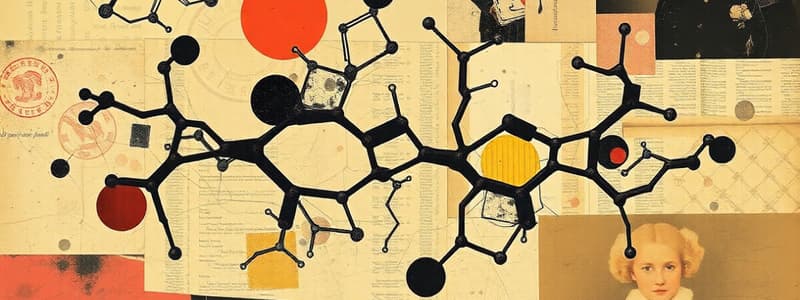Podcast
Questions and Answers
What type of bond is formed between two amino acids during a condensation reaction?
What type of bond is formed between two amino acids during a condensation reaction?
- Hydrogen bond
- Ionic bond
- Peptide bond (correct)
- Disulfide bond
Which term refers to a peptide consisting of 3 amino acid residues?
Which term refers to a peptide consisting of 3 amino acid residues?
- Polypeptide
- Tripeptide (correct)
- Oligopeptide
- Dipeptide
Which of the following peptides is known to consist of 9 amino acid residues?
Which of the following peptides is known to consist of 9 amino acid residues?
- Insulin
- Glucagon
- Oxytocin (correct)
- Glutathione
What is the terminology used for the residue at the end of a peptide with a free carboxyl group?
What is the terminology used for the residue at the end of a peptide with a free carboxyl group?
Which function does insulin primarily serve in the body?
Which function does insulin primarily serve in the body?
Polypeptides are classified as having how many amino acid residues?
Polypeptides are classified as having how many amino acid residues?
Which of the following proteins is primarily involved in blood clotting?
Which of the following proteins is primarily involved in blood clotting?
Which component is considered part of the polypeptide backbone?
Which component is considered part of the polypeptide backbone?
What role do hydrogen bonds play in the stability of protein structures?
What role do hydrogen bonds play in the stability of protein structures?
Which amino acid is known to terminate a helix structure by introducing a kink?
Which amino acid is known to terminate a helix structure by introducing a kink?
What characterizes an anti-parallel beta-pleated sheet?
What characterizes an anti-parallel beta-pleated sheet?
Which type of interaction is NOT involved in stabilizing tertiary protein structure?
Which type of interaction is NOT involved in stabilizing tertiary protein structure?
What is the main characteristic of the quaternary structure of a protein?
What is the main characteristic of the quaternary structure of a protein?
What describes the primary structure of a protein?
What describes the primary structure of a protein?
What is primarily responsible for the formation of secondary structures like alpha helices and beta sheets?
What is primarily responsible for the formation of secondary structures like alpha helices and beta sheets?
Which of the following amino acid substitutes in hemoglobin is associated with sickle cell disease?
Which of the following amino acid substitutes in hemoglobin is associated with sickle cell disease?
What structural feature stabilizes the alpha helix in proteins?
What structural feature stabilizes the alpha helix in proteins?
What characterizes tertiary structure in proteins?
What characterizes tertiary structure in proteins?
Which of the following plays a critical role in the strength of silk fibers?
Which of the following plays a critical role in the strength of silk fibers?
How many amino acid residues are typically present in one turn of an alpha helix?
How many amino acid residues are typically present in one turn of an alpha helix?
What characterizes quaternary structure in proteins?
What characterizes quaternary structure in proteins?
What is the primary function of the stationary phase in column chromatography?
What is the primary function of the stationary phase in column chromatography?
In partition chromatography, what does the partition coefficient represent?
In partition chromatography, what does the partition coefficient represent?
Which type of chromatography separates proteins based on their size?
Which type of chromatography separates proteins based on their size?
What is the role of porous beads in size exclusion chromatography?
What is the role of porous beads in size exclusion chromatography?
What method is used to calculate the behavior of an amino acid or protein with a solvent in chromatography?
What method is used to calculate the behavior of an amino acid or protein with a solvent in chromatography?
What is the first step in absorption chromatography?
What is the first step in absorption chromatography?
In what type of chromatography is a thin layer of silica or alumina often used?
In what type of chromatography is a thin layer of silica or alumina often used?
What type of proteins remain in the flowing mobile phase in size exclusion chromatography?
What type of proteins remain in the flowing mobile phase in size exclusion chromatography?
What technique is used to gradually release proteins by disrupting the protein-stationary phase complex?
What technique is used to gradually release proteins by disrupting the protein-stationary phase complex?
In ion exchange chromatography, what type of molecules bind to cation exchangers?
In ion exchange chromatography, what type of molecules bind to cation exchangers?
What influences the binding affinity of a protein in ion exchange chromatography?
What influences the binding affinity of a protein in ion exchange chromatography?
Which group is commonly attached to anion exchangers for protein binding?
Which group is commonly attached to anion exchangers for protein binding?
How do negatively charged amino acids behave in an electric field during electrophoresis?
How do negatively charged amino acids behave in an electric field during electrophoresis?
Which method confirms the effects of mutations and is crucial for vaccine synthesis?
Which method confirms the effects of mutations and is crucial for vaccine synthesis?
What happens to bound proteins in ion exchange chromatography when the concentration of monovalent ions is increased?
What happens to bound proteins in ion exchange chromatography when the concentration of monovalent ions is increased?
In the context of protein purification, what is the role of pH in the mobile phase?
In the context of protein purification, what is the role of pH in the mobile phase?
Flashcards are hidden until you start studying
Study Notes
Peptides
- Polymers of amino acids
- Consist of two or three to thousands of linked amino acid residues
- Dipeptide: two amino acid molecules joined by a peptide bond
Condensation and Hydrolytic Reactions
- Dehydration reaction: removes a hydroxyl group and a hydrogen to form a covalent peptide bond
- Polypeptide backbone: repeating sequence of N-C-C-N-C-C… in the peptide bond
- Side chains (R groups) are not part of the backbone or the peptide bond
- Amino-terminal (N-terminal) residue: has a free -amino group
- Carboxyl-terminal (C-terminal) residue: has a free carboxyl group
Biologically Active Peptides
- Oxytocin: 9 amino acid residues (gly-leu-pro-cys-asn-gln-ile-tyr-cys)
- Glutathione: 3 amino acid residues (glu-cys-gly)
- Insulin: 51 amino acid residues
- Glucagon: 29 amino acid residues
- Adrenocorticotrophic hormone: 39 amino acid residues
Glutathione
- Tripeptide (glu-cys-gly)
Classification of Peptides
- Classified based on the number of amino acid residues:
- Dipeptide: 2
- Tripeptide: 3
- Nanopeptide: 9
- Oligopeptide: 10 to 20
- Polypeptide: More than several dozens
Classification of Proteins
- Classified based on composition, shape, function, and solubility
Functions of Proteins
- Biological catalysts (enzymes)
- Hormones (insulin, glucagon)
- Neurotransmitters (glycine)
- Defense (antibodies)
- Transport in the body (albumin, hemoglobin)
- Locomotion (actin, myosin)
- Blood clotting (thrombin, fibrinogen)
- Structural (collagen, elastin, keratin)
Levels of Protein Organization
- Primary Structure: Amino acid sequence of the protein
- Secondary Structure: H bonds in the peptide chain backbone (alpha-helix and beta-sheets)
- Tertiary Structure: Non-covalent/covalent interactions between R groups within the protein
- Quaternary Structure: Interaction between 2 polypeptide chains
Primary Structure
- Unique sequence of amino acids
- Lysozyme: polypeptide chain of 129 amino acids
- Sickle cell disease: abnormal hemoglobins due to a single amino acid substitution
- Most abundant amino acids: Leu, Ala, Gly, Ser, Val, and Glu
- Rarest amino acids: Trp, Cys, Met, and His
- Amino acid sequence determines protein characteristics more than composition
Secondary Structure
- Results from hydrogen bonds along the polypeptide backbone
- Alpha-helix: coils
- Beta-pleated sheets: folds
- Silk fibers: strong due to many hydrogen bonds (beta pleated sheets)
Protein Folding: Secondary Structure
- Two regular folding patterns
- Alpha-helix: protein turns like a spiral (found in fibrous proteins like hair, nails, and horns)
- Beta-sheet: protein folds back on itself like a ribbon (found in globular proteins)
Features of Alpha-Helix
- Backbone tightly wound along an axis
- 3.6 amino acid residues per turn
- R groups project outwards
- Stabilized by hydrogen bonds between N-H and C=O groups (4 residues back)
- Each peptide bond participates in hydrogen bonding
- Most fibrous tissues have right-handed alpha-helices (more stable)
- Aromatic amino acids, charged, and hydrophobic amino acids can destabilize
- Glycine can cause coiling of the helix
- Proline terminates the helix by causing a kink
Features of Beta-Sheet
- Polypeptide chain fully extended
- 2-5 chains arranged side by side
- Can have chains running in the same direction (parallel beta-sheet)
- Can have chains running in opposite directions (anti-parallel beta-sheet)
- Stabilized by interchain hydrogen bonds
- Anti-parallel chains are more stable due to stronger hydrogen bonds
Tertiary Structure
- Determined by interactions among R groups and the polypeptide backbone
- Interactions include: hydrogen bonds, ionic bonds, hydrophobic interactions, van der Waals interactions
Quaternary Structure
- Aggregation of two or more polypeptide subunits
- Hemoglobin: globular protein with two copies of two kinds of polypeptides
- Lactate dehydrogenase, creatine phosphokinase
Protein Folding
- The peptide bond allows rotation and folding
- Weak non-covalent interactions (hydrogen bonds, electrostatic interactions, van der Waals forces) maintain the functional shape
Bonds Involved in Protein Folding
- Hydrophobic interactions
- Hydrogen bonds
- Electrostatic interactions (salt linkages)
- Van der Waals forces
Protein Conformation and Function
- Conformation gives a protein its unique function
- Proteins must interact with other molecules to work
Techniques for Separating and Purifying Proteins
- Dialysis
- Chromatography
- Paper Chromatography
- Thin-layer Chromatography (TLC)
- Column Chromatography
Column Chromatography
- Stationary phase: small spherical beads coated with chemical functional groups
- Mobile phase: liquid percolated through the column
- Proteins interact based on charge, hydrophobicity, or ligand-binding properties
Partition Chromatography
- Separation based on relative affinity of proteins for the stationary and mobile phases
- Proteins with a stronger affinity for the stationary phase are retained longer
- Retention time is affected by the composition of both phases
- Retardation factor (Rf) can be calculated for an amino acid/protein in a solvent.
Size Exclusion Chromatography
- Separates proteins based on size (molecular mass and shape)
- Also known as Gel Filtration
- Proteins too large to enter the pores are excluded and emerge first
- Proteins emerge in descending order of size
Absorption Chromatography
- Protein mixture is applied under conditions where the target protein strongly associates with the stationary phase
- Non-adhering molecules are eluted first and discarded
- Proteins are sequentially released by altering the forces that stabilize the protein-stationary phase complex (using a gradient of increasing salt concentration or changing pH)
Ion Exchange Chromatography
- Charged molecules bind to oppositely charged groups on a matrix
- Anions bind to cationic groups (anion exchangers)
- Cations bind to anionic groups (cation exchangers)
- DEAE (diethylaminoethyl) groups: anion exchanger
- CM (carboxymethyl) groups: cation exchanger
- Binding affinity depends on competing ions and the pH
- Proteins with a net negative charge adhere to positively charged beads (anion exchangers)
- Proteins compete with monovalent ions for binding
- Bound proteins are displaced by increasing the concentration of monovalent ions in the mobile phase
- Changing pH can achieve sequential elution
Electrophoresis
- Movement of ions in an electrical field
- Positively charged amino acids move towards the cathode
- Negatively charged amino acids move towards the anode
- Uncharged amino acids remain at the point of application
Importance of Protein Sequencing
- Confirms effects of mutation
- Key in vaccine synthesis (knowledge of proteins on viral membranes)
- Explains mechanisms of enzyme catalysis
- Key in DNA cloning
Studying That Suits You
Use AI to generate personalized quizzes and flashcards to suit your learning preferences.




